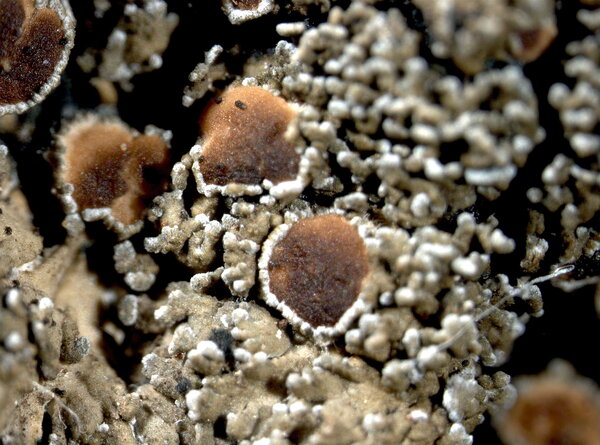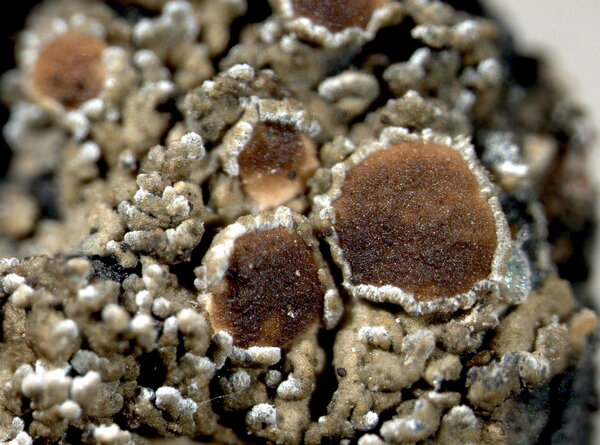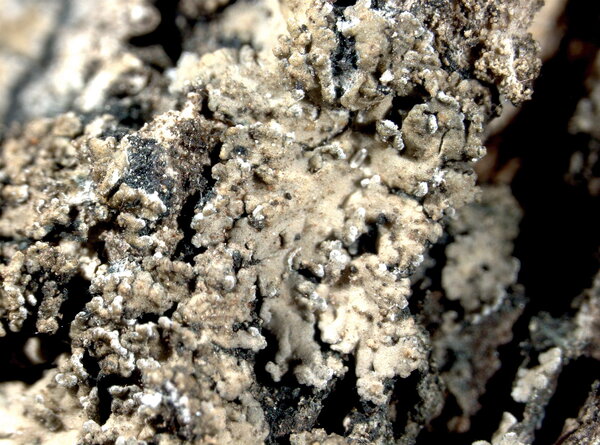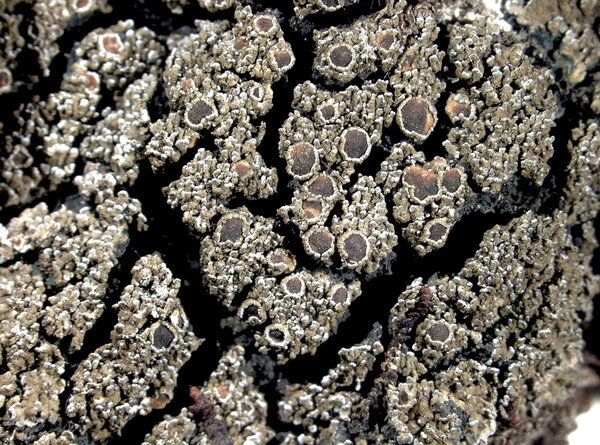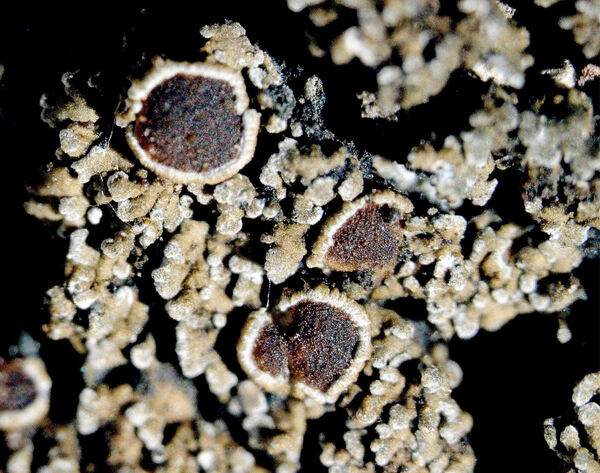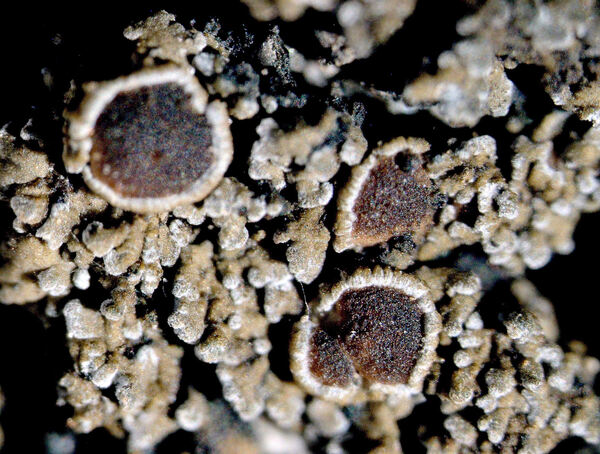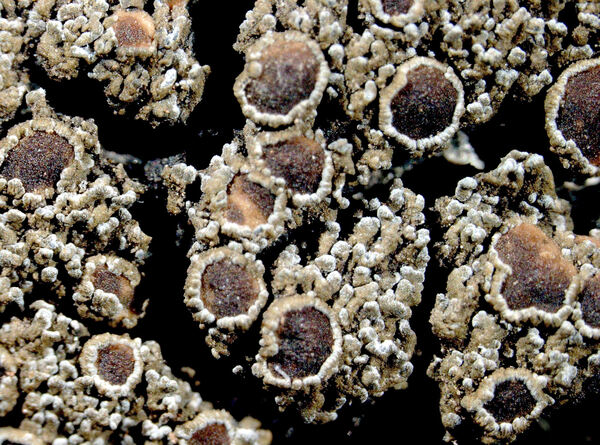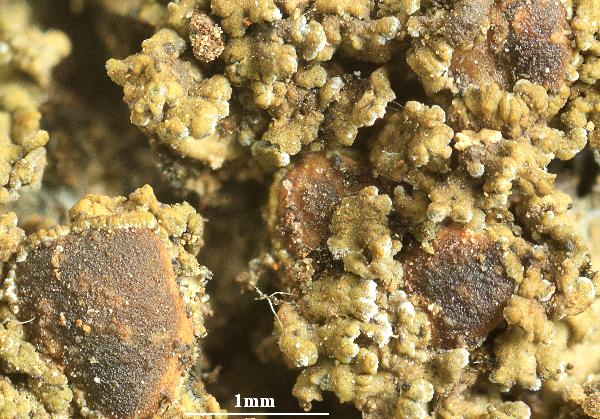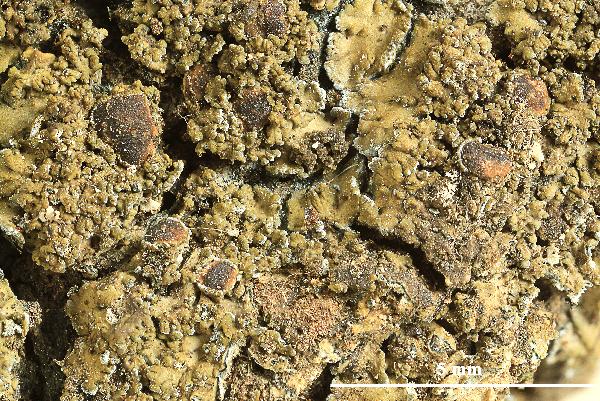Fuscopannaria olivacea (P.M. Jørg.) P.M. Jørg.
J. Hattori Bot. Lab., 76: 205, 1994. Basionym: Pannaria olivacea P.M. Jørg. - Opera Bot., 45: 49, 1978.
Synonyms:
Distribution: N - Lig. C - Tosc (Benesperi 2011), Laz (Ravera 2001, Massari & Ravera 2002), Abr (Nimis & Tretiach 1999), Sar (Zedda 1995, 2002). S - Camp (Nimis & Tretiach 2004, Garofalo & al. 2010, Brunialti & al. 2013, Ravera & Brunialti 2013, Catalano & al. 2016), Cal (Puntillo 1996, Puntillo & Puntillo 2004).
Description: Thallus crustose-subsquamulose, heteromerous, of 1-1.5 mm wide, 110-190 μm thick, olive-brown, slightly to deeply incised squamules with a white-felted, undulating margin and lower surface, developing on a blue-black hypothallus. Upper cortex paraplectenchymatous 30-40 μm thick, of thick-walled cells; medulla c. 50 μm thick; lower cortex absent. Apothecia lecanorine, 0.5-1.2 mm across, with a flat to finally convex, reddish brown disc, and a more or less crenulate, persistent, sometimes white-felted thalline margin. Proper exciple paraplectenchymatous, c. 40 μm wide; epithecium brown; hymenium colourless, 80-140 μm high, hemiamyloid, I+ green-blue turning reddish; paraphyses coherent, simple, the apical cells slightly swollen; hypothecium colourless to yellowish, paraplectenchymatous, 120-140 μm high. Asci 8-spored, subcylindrical to clavate, with a I+ blue tholus and an internal, more intensely I+ blue apical plug. Ascospores 1-celled, hyaline, ellipsoid, usually with a large guttule, the apices rounded, with a distinct epispore, measuring 13-17 x 7-10 μm without epispore, 17-22.5 x 9.5-12 μm including the epispore. Photobiont cyanobacterial (Nostoc, the cells in short clusters). Spot tests: thallus K-, C-, KC-, P-, UV-. Chemistry: without lichen substances.
Note: a mild-temperate to Mediterranean species found on bark and mossy trunks in humid broad-leaved woodlands; typically Tyrrhenian (the record from Abruzzo is exceptional).
Growth form: Squamulose
Substrata: bark
Photobiont: cyanobacteria, filamentous (e.g. Nostoc, Scytonema)
Reproductive strategy: mainly sexual
Most common in areas with a humid-warm climate (e.g. most of Tyrrenian Italy)
Commonnes-rarity: (info)
Alpine belt: absent
Subalpine belt: absent
Oromediterranean belt: absent
Montane belt: absent
Submediterranean belt: extremely rare
Padanian area: absent
Humid submediterranean belt: very rare
Humid mediterranean belt: rare
Dry mediterranean belt: absent

Predictive model
Herbarium samples
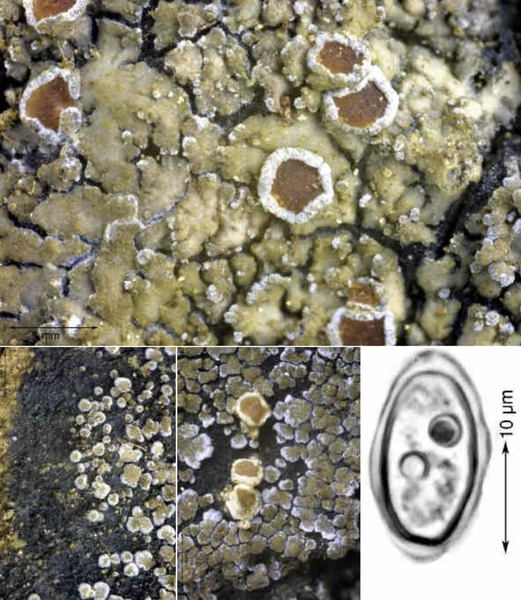

Felix Schumm – CC BY-SA 4.0
Image from: F. Schumm (2008) - Flechten Madeiras, der Kanaren und Azoren. Beck, OHG - ISBN: 978-3-00-023700-3
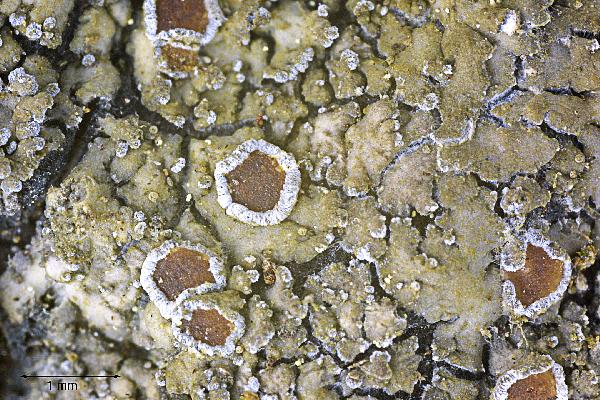

Felix Schumm - CC BY-SA 4.0
[12429], Griechenland, N-Samos, südlich von Agios Konstandinos, an
der Straße nach Manolates (ca. 37°47'N, 26°49' E), bei ca. 131 m. Leg.
R. Düll, Maier, F. Schumm, 05.05.2006, det. P.M. Jørgensen, 2007. -
Sporen mit beihnahe glattem Epispor, 19,6 x 9,8 μm; Ascuswände J+
rot.
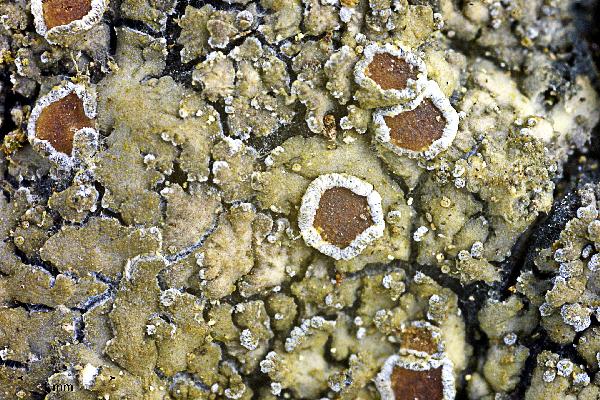

Felix Schumm - CC BY-SA 4.0
[12429], Griechenland, N-Samos, südlich von Agios Konstandinos, an
der Straße nach Manolates (ca. 37°47'N, 26°49' E), bei ca. 131 m. Leg.
R. Düll, Maier, F. Schumm, 05.05.2006, det. P.M. Jørgensen, 2007. -
Sporen mit beihnahe glattem Epispor, 19,6 x 9,8 μm; Ascuswände J+
rot.


Felix Schumm - CC BY-SA 4.0
[12429], Griechenland, N-Samos, südlich von Agios Konstandinos, an
der Straße nach Manolates (ca. 37°47'N, 26°49' E), bei ca. 131 m. Leg.
R. Düll, Maier, F. Schumm, 05.05.2006, det. P.M. Jørgensen, 2007. -
Sporen mit beihnahe glattem Epispor, 19,6 x 9,8 μm; Ascuswände J+
rot.
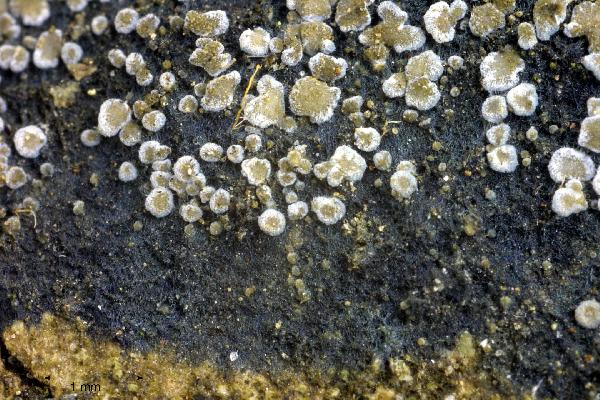

Felix Schumm - CC BY-SA 4.0
[12429], Griechenland, N-Samos, südlich von Agios Konstandinos, an
der Straße nach Manolates (ca. 37°47'N, 26°49' E), bei ca. 131 m. Leg.
R. Düll, Maier, F. Schumm, 05.05.2006, det. P.M. Jørgensen, 2007. -
Sporen mit beihnahe glattem Epispor, 19,6 x 9,8 μm; Ascuswände J+
rot.


Felix Schumm - CC BY-SA 4.0
[12429], Griechenland, N-Samos, südlich von Agios Konstandinos, an
der Straße nach Manolates (ca. 37°47'N, 26°49' E), bei ca. 131 m. Leg.
R. Düll, Maier, F. Schumm, 05.05.2006, det. P.M. Jørgensen, 2007. -
Sporen mit beihnahe glattem Epispor, 19,6 x 9,8 μm; Ascuswände J+
rot.
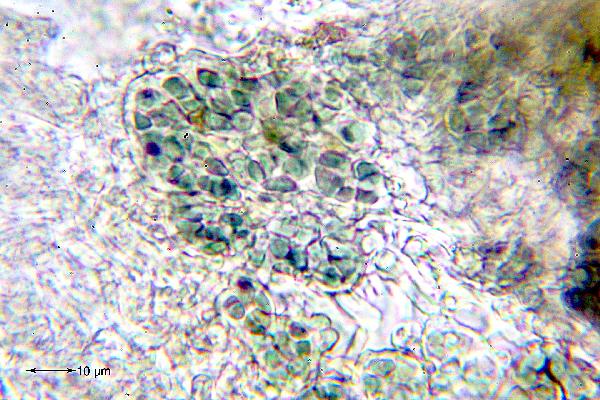

Felix Schumm - CC BY-SA 4.0
[12429], Griechenland, N-Samos, südlich von Agios Konstandinos, an
der Straße nach Manolates (ca. 37°47'N, 26°49' E), bei ca. 131 m. Leg.
R. Düll, Maier, F. Schumm, 05.05.2006, det. P.M. Jørgensen, 2007. -
Sporen mit beihnahe glattem Epispor, 19,6 x 9,8 μm; Ascuswände J+
rot.
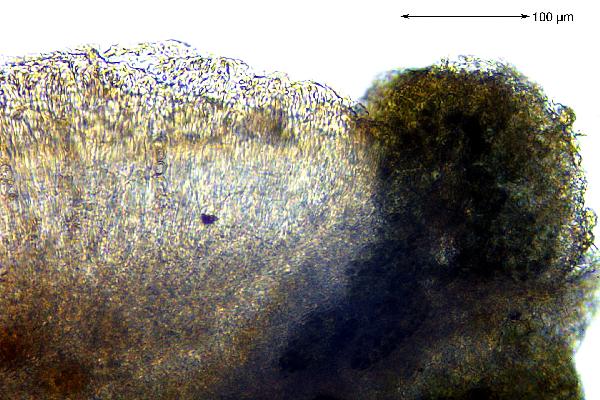

Felix Schumm - CC BY-SA 4.0
[12429], Griechenland, N-Samos, südlich von Agios Konstandinos, an
der Straße nach Manolates (ca. 37°47'N, 26°49' E), bei ca. 131 m. Leg.
R. Düll, Maier, F. Schumm, 05.05.2006, det. P.M. Jørgensen, 2007. -
Sporen mit beihnahe glattem Epispor, 19,6 x 9,8 μm; Ascuswände J+
rot.
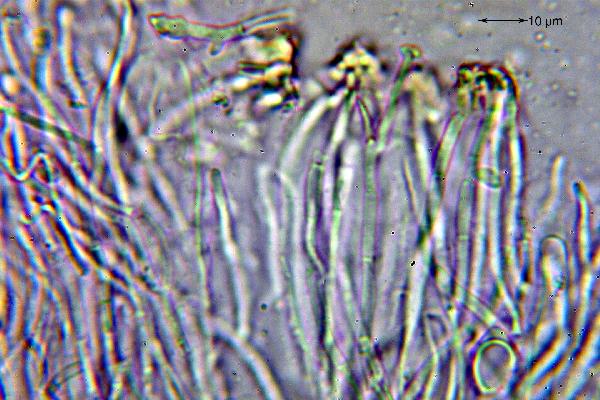

Felix Schumm - CC BY-SA 4.0
[12429], Griechenland, N-Samos, südlich von Agios Konstandinos, an
der Straße nach Manolates (ca. 37°47'N, 26°49' E), bei ca. 131 m. Leg.
R. Düll, Maier, F. Schumm, 05.05.2006, det. P.M. Jørgensen, 2007. -
Sporen mit beihnahe glattem Epispor, 19,6 x 9,8 μm; Ascuswände J+
rot.
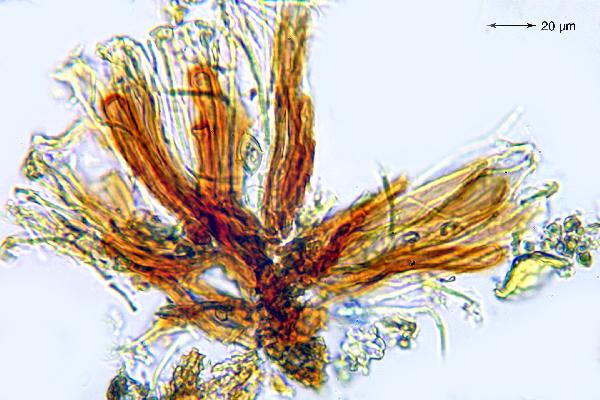

Felix Schumm - CC BY-SA 4.0
[12429], Griechenland, N-Samos, südlich von Agios Konstandinos, an
der Straße nach Manolates (ca. 37°47'N, 26°49' E), bei ca. 131 m. Leg.
R. Düll, Maier, F. Schumm, 05.05.2006, det. P.M. Jørgensen, 2007. -
Sporen mit beihnahe glattem Epispor, 19,6 x 9,8 μm; Ascuswände J+
rot.
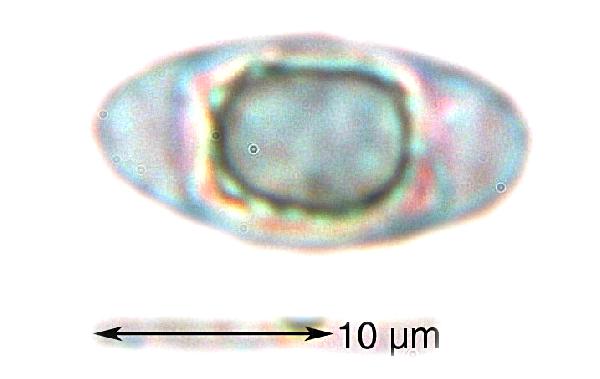

Felix Schumm - CC BY-SA 4.0
[12429], Griechenland, N-Samos, südlich von Agios Konstandinos, an
der Straße nach Manolates (ca. 37°47'N, 26°49' E), bei ca. 131 m. Leg.
R. Düll, Maier, F. Schumm, 05.05.2006, det. P.M. Jørgensen, 2007. -
Sporen mit beihnahe glattem Epispor, 19,6 x 9,8 μm; Ascuswände J+
rot.
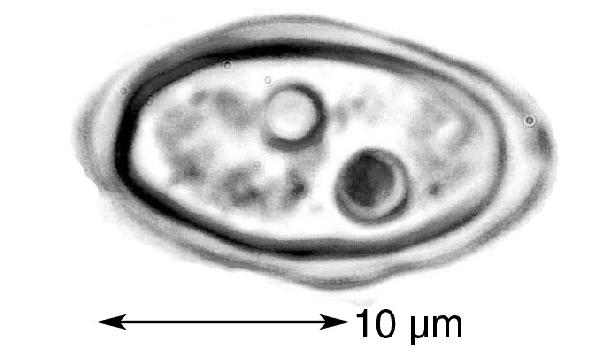

Felix Schumm - CC BY-SA 4.0
[12429], Griechenland, N-Samos, südlich von Agios Konstandinos, an
der Straße nach Manolates (ca. 37°47'N, 26°49' E), bei ca. 131 m. Leg.
R. Düll, Maier, F. Schumm, 05.05.2006, det. P.M. Jørgensen, 2007. -
Sporen mit beihnahe glattem Epispor, 19,6 x 9,8 μm; Ascuswände J+
rot.


Felix Schumm - CC BY-SA 4.0
[VZ2004], Graecia, Creta, Kaloniktis prope Rethimnon, 300 m. Ad
corticem arborum (Quercus macrolepidis). Leg. E. Sérusiaux (6240),
94.1984. EX A. V ZDA: LICHENES SELECCTI EXSICCATI NR. 2004.
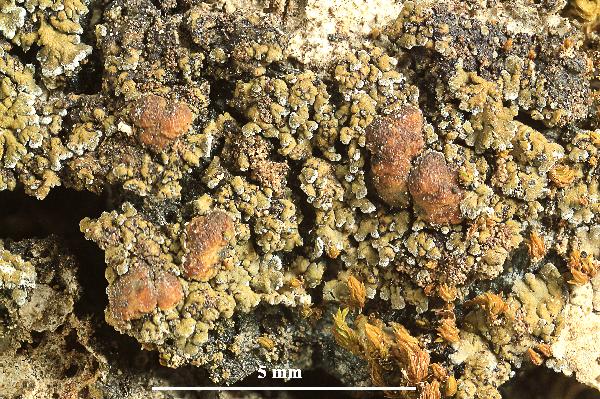

Felix Schumm - CC BY-SA 4.0
[VZ2004], Graecia, Creta, Kaloniktis prope Rethimnon, 300 m. Ad
corticem arborum (Quercus macrolepidis). Leg. E. Sérusiaux (6240),
94.1984. EX A. V ZDA: LICHENES SELECCTI EXSICCATI NR. 2004.
Growth form: Squamulose
Substrata: bark
Photobiont: cyanobacteria, filamentous (e.g. Nostoc, Scytonema)
Reproductive strategy: mainly sexual
Most common in areas with a humid-warm climate (e.g. most of Tyrrenian Italy)
Commonnes-rarity: (info)
Alpine belt: absent
Subalpine belt: absent
Oromediterranean belt: absent
Montane belt: absent
Submediterranean belt: extremely rare
Padanian area: absent
Humid submediterranean belt: very rare
Humid mediterranean belt: rare
Dry mediterranean belt: absent

Predictive model
| Herbarium samples |


Felix Schumm – CC BY-SA 4.0
Image from: F. Schumm (2008) - Flechten Madeiras, der Kanaren und Azoren. Beck, OHG - ISBN: 978-3-00-023700-3


Felix Schumm - CC BY-SA 4.0
[12429], Griechenland, N-Samos, südlich von Agios Konstandinos, an der Straße nach Manolates (ca. 37°47'N, 26°49' E), bei ca. 131 m. Leg. R. Düll, Maier, F. Schumm, 05.05.2006, det. P.M. Jørgensen, 2007. - Sporen mit beihnahe glattem Epispor, 19,6 x 9,8 μm; Ascuswände J+ rot.


Felix Schumm - CC BY-SA 4.0
[12429], Griechenland, N-Samos, südlich von Agios Konstandinos, an der Straße nach Manolates (ca. 37°47'N, 26°49' E), bei ca. 131 m. Leg. R. Düll, Maier, F. Schumm, 05.05.2006, det. P.M. Jørgensen, 2007. - Sporen mit beihnahe glattem Epispor, 19,6 x 9,8 μm; Ascuswände J+ rot.


Felix Schumm - CC BY-SA 4.0
[12429], Griechenland, N-Samos, südlich von Agios Konstandinos, an der Straße nach Manolates (ca. 37°47'N, 26°49' E), bei ca. 131 m. Leg. R. Düll, Maier, F. Schumm, 05.05.2006, det. P.M. Jørgensen, 2007. - Sporen mit beihnahe glattem Epispor, 19,6 x 9,8 μm; Ascuswände J+ rot.


Felix Schumm - CC BY-SA 4.0
[12429], Griechenland, N-Samos, südlich von Agios Konstandinos, an der Straße nach Manolates (ca. 37°47'N, 26°49' E), bei ca. 131 m. Leg. R. Düll, Maier, F. Schumm, 05.05.2006, det. P.M. Jørgensen, 2007. - Sporen mit beihnahe glattem Epispor, 19,6 x 9,8 μm; Ascuswände J+ rot.


Felix Schumm - CC BY-SA 4.0
[12429], Griechenland, N-Samos, südlich von Agios Konstandinos, an der Straße nach Manolates (ca. 37°47'N, 26°49' E), bei ca. 131 m. Leg. R. Düll, Maier, F. Schumm, 05.05.2006, det. P.M. Jørgensen, 2007. - Sporen mit beihnahe glattem Epispor, 19,6 x 9,8 μm; Ascuswände J+ rot.


Felix Schumm - CC BY-SA 4.0
[12429], Griechenland, N-Samos, südlich von Agios Konstandinos, an der Straße nach Manolates (ca. 37°47'N, 26°49' E), bei ca. 131 m. Leg. R. Düll, Maier, F. Schumm, 05.05.2006, det. P.M. Jørgensen, 2007. - Sporen mit beihnahe glattem Epispor, 19,6 x 9,8 μm; Ascuswände J+ rot.


Felix Schumm - CC BY-SA 4.0
[12429], Griechenland, N-Samos, südlich von Agios Konstandinos, an der Straße nach Manolates (ca. 37°47'N, 26°49' E), bei ca. 131 m. Leg. R. Düll, Maier, F. Schumm, 05.05.2006, det. P.M. Jørgensen, 2007. - Sporen mit beihnahe glattem Epispor, 19,6 x 9,8 μm; Ascuswände J+ rot.


Felix Schumm - CC BY-SA 4.0
[12429], Griechenland, N-Samos, südlich von Agios Konstandinos, an der Straße nach Manolates (ca. 37°47'N, 26°49' E), bei ca. 131 m. Leg. R. Düll, Maier, F. Schumm, 05.05.2006, det. P.M. Jørgensen, 2007. - Sporen mit beihnahe glattem Epispor, 19,6 x 9,8 μm; Ascuswände J+ rot.


Felix Schumm - CC BY-SA 4.0
[12429], Griechenland, N-Samos, südlich von Agios Konstandinos, an der Straße nach Manolates (ca. 37°47'N, 26°49' E), bei ca. 131 m. Leg. R. Düll, Maier, F. Schumm, 05.05.2006, det. P.M. Jørgensen, 2007. - Sporen mit beihnahe glattem Epispor, 19,6 x 9,8 μm; Ascuswände J+ rot.


Felix Schumm - CC BY-SA 4.0
[12429], Griechenland, N-Samos, südlich von Agios Konstandinos, an der Straße nach Manolates (ca. 37°47'N, 26°49' E), bei ca. 131 m. Leg. R. Düll, Maier, F. Schumm, 05.05.2006, det. P.M. Jørgensen, 2007. - Sporen mit beihnahe glattem Epispor, 19,6 x 9,8 μm; Ascuswände J+ rot.


Felix Schumm - CC BY-SA 4.0
[12429], Griechenland, N-Samos, südlich von Agios Konstandinos, an der Straße nach Manolates (ca. 37°47'N, 26°49' E), bei ca. 131 m. Leg. R. Düll, Maier, F. Schumm, 05.05.2006, det. P.M. Jørgensen, 2007. - Sporen mit beihnahe glattem Epispor, 19,6 x 9,8 μm; Ascuswände J+ rot.


Felix Schumm - CC BY-SA 4.0
[VZ2004], Graecia, Creta, Kaloniktis prope Rethimnon, 300 m. Ad corticem arborum (Quercus macrolepidis). Leg. E. Sérusiaux (6240), 94.1984. EX A. V ZDA: LICHENES SELECCTI EXSICCATI NR. 2004.


 INDEX FUNGORUM
INDEX FUNGORUM
 GBIF
GBIF
